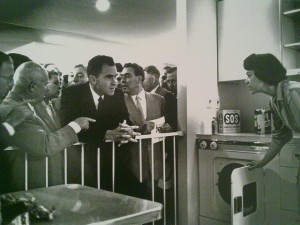In the  summer of 1959 then-Vice President Richard Nixon flew to Moscow to speak at the opening of the American National Exhibition. The exhibit was intended to showcase the advantages of American capitalism to the Soviets. Nixon and Soviet Premier ÂNikita Khrushchev, accompanied by an army of reporters, toured the life-sized model of the “typical American home.” It was a ranch style three-bedroom house made by All-State Properties of suburban Long Island. “I want to show you this kitchen,” said Nixon to his boisterous host. “It is like those of our houses in California.”
summer of 1959 then-Vice President Richard Nixon flew to Moscow to speak at the opening of the American National Exhibition. The exhibit was intended to showcase the advantages of American capitalism to the Soviets. Nixon and Soviet Premier ÂNikita Khrushchev, accompanied by an army of reporters, toured the life-sized model of the “typical American home.” It was a ranch style three-bedroom house made by All-State Properties of suburban Long Island. “I want to show you this kitchen,” said Nixon to his boisterous host. “It is like those of our houses in California.”
Thus started the exchange known as The Kitchen Debate.
This was during the height of the Cold War and just two years after the Soviets launched the satellite Sputnik, beating the U.S. into space. And there was a young Nixon, according to his memoirs with a head full of Tolstoy and other Russian writers, in an impromptu debate partially captured on Ampex color videotape with modern GE appliances as set dressings. A perfect 1950s political and technological snapshot.
The Soviet press had dubbed the dwelling Taj Mahal. “Don’t you have a machine that puts food into the mouth and pushes it down?” Quipped Khrushchev through an interpreter. “Many things you’ve shown us are interesting but they are not needed in life. They have no useful purpose. They are merely gadgets.”
The builder of the modest American home, All-State Properties proclaimed their homes were a “secret weapon” in the Cold War. “It gave ordinary Americans a high standard of living and inoculated them against the contagion of radical ideas,” writes historian Clifton Hood.
Nixon touting mortgages from the Veterans Administration or the Federal Housing Authority relayed, “Any steel worker could buy this house. They earn $3 an hour. This house costs about $100 a month to buy on a contract running 25 to 30 years.”
Nixon was having a back and forth with an actual communist””not an imagined one. And the answer to actual communism was quality of life: People could afford a home filled with gadgets by working. The actual communist dismissed these staples as unnecessary””things people could do without so the state could build more rockets.
This October, Americans will be subjected to three televised presidential debates. It’s clear the parameters of the Cold War are gone. Now it’s between Nixon Republicanism, offered by Obama (derided as socialism, conflated with communism) and the corporate divinity offered by Mitt Romney.
“You should be able to make it if you work hard,” says Obama on the stump. “You should be able to get ahead if you act responsibly. It’s that idea that built the strongest middle class on earth, and made us an economic superpower.”
Contrast that with Romney: “There are 47 percent who are with [Obama], who are dependent upon government, who believe that they are victims, who believe that government has a responsibility to care for them, who believe that they are entitled to health care, to food, to housing, to you name it.” To Romney, these are things we can do without so the state can give rich people more tax breaks (and build a bigger military).
In 50 years, the Republicans have gone from building the middle class with the aid of government to admonishing the middle class for utilizing government. At the RNC the speakers who mentioned their family’s economic rise actually showcased the government programs they now oppose: Chris Christie’s father took advantage of the GI bill; Paul Ryan went to college using his father’s Social Security; Romney’s family (according to his mother) was on welfare when they came back from Mexico. It goes to the core of the GOP message this year: We’re not going to cut your benefits””just the other guy’s. With the fine print: Also we’re going to have to cut your benefits.
Our socio-economic debate has definitely moved out of the proverbial kitchen ” and through the looking glass.